Great Wall Hiking to Baiyangyu |
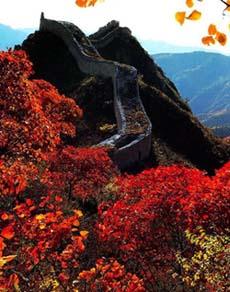 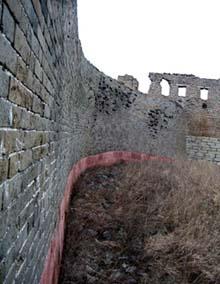 Marble Wall 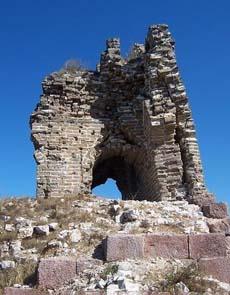 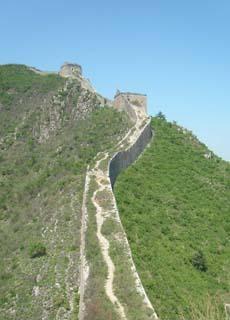 |
Baiyangyu Great Wall
White Sheep Valley, Marble Great Wall
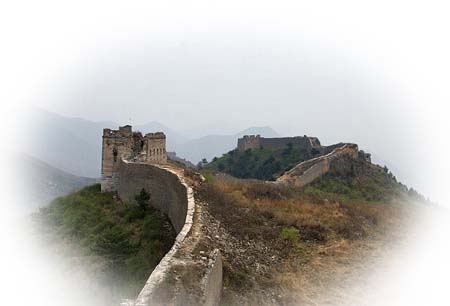
If you’d like to have a weekend hike on a wide and overgrown section of the Great Wall around Beijing, Baiyangyu Great Wall is highly recommended. This section of the Wall is located about 250km northeast of Beijing. It is under the administration of Dacuizhuang Town of Qian’an County in Tangshan City, Hebei Province. “Baiyangyu” literally means “White Sheep Valley”. A river called Baiyang River passes the valley from north to south. There used to be a grand water pass of the Great Wall bridging the valley which now still divides the Baiyangyu Great Wall into two sections – East and West. The two sections of Bauyangyu Great wall are a 4552m-long fairly well preserved wall with 21 guide-towers. Baiyangyu Great Wall was originally built in Northen Qi Dynasty (550-577) and reinforced in Ming Dynasty (1368 – 1644) by the builders and army led by Qi Juguang.
Baiyangyu Great Wall has some unique features different from other sections of the Wall. Firstly, its water pass town had a double water wall – upper part and lower part, constituting a solid water town which was easy for self-defense and attacking invaders as well, part of the military defense system in Baiyangyu Great wall. Second, the east section of the Wall has a 1.5km unique marble wall, 10km high and 5m wide, rarely seen among other sections of the wall. Third, among other towers, Shenwei Tower (Powerful Tower) on the west section of Baiyangyu Great Wall is the most remarkable. Unlike other watch-towers sitting on the wall, it was constructed to the outer side of the wall. If you walk eastward from Baiyangyu Great Wall, you will reach Xuliukou Great Wall and on to Shanhaiguan Pass meeting the ocean; walking westward, you get to Badaling Great Wall around Beijing.
Shenwei Tower, different from other watch-towers sitting on the wall, was built against the outer side of the wall. Its four walls were built of black bricks up to the rafter of the eaves pointed with mortar. An arrow-shaped opening dug in the middle of the back exposed wall served as a window for fresh air and sunlight as weIl as a loophole for watching the enemy. It was also the place for arrow shooting and shell firing. Below the arrow-shaped opening are some stone missile holes for throwing stones on the invaders down the tower The arrow-shaped opening and stone missile holes ranged like the Chinese character “品”. The structure of the east and west walls is similar to the exposed wall. The inside of the tower is an oblong arched room. A Stone tablet was set on the upper lintel of the house with “神威楼” ( Powerful Tower ) three Chinese characters inscribed in intaglio regular script, with a signature of " Zhangshizhong, a guerrilla general, in a mid-summer of the year of Bingshen of the permanent calendar. " A screen wall was built opposite the arch with a record board inlaid on. The whole tower was constructed without a piece of wood and tile except for the gate and openings. The wood - like stone structure strengthened the solidness of the tower. East of Shenwei Tower ( the Powerful Tower ) stands a wood-beam structured watchtower which is unique among many brick arched-towers. There are many wall cabinets inside the tower, which is rarely seen on the Great Wall.
The stone wall is mainly distributed in the sections which are far from the pass and easy to hold but hard to attack. The wall between Fangzi Tower and Kengzi Tower, the main component of the Baiyangyu Pass, was built of huge rubbles piling up without a single brick, even for the crenel and parapet. It has remained intact for over 400 years. In the east section of the double brick-coated wall, there are two stone monuments set on its interior. On each of them were written "The west boundary of the Dongxieyanhe region" and "The east boundary of Zhongxietaiping region" in regular script. During the Ming Dynasty, the Great Wall within the boundary of Tangshan was under the administration of Ji Town, one of the nine towns. Ji Town had twelve regions, each was responsible for the renovation and defense of the Great Wall attached. Stone tablets were erected while constructing walls on the border between regions. These two stone tablets are the boundary tablets between Yanhe region and Taiping region.
West of the boundary tablet, hoary limestone is used as the base of the wall and the watchtowers, while 2,100 meters east of the boundary tablet, purple marble are used as their base. The red and white at the jointing point look strikingly in contrast. This is known as the “Marble Great Wall”. East of the marble Great Wall lies a branch wall which is called the wrong wall by the natives. A general’s tomb stands nearby. It’s said that the wrong wall was the result of a direction mistake which caused the general’s death. Some others said the wrong wall shared the same function as the Lying Town to confuse the enemy. As a matter of fact, the additional wall built at this strategic important point was to strengthen the defense.
The Lying Town, also known as “the Stable" and "the Parade Town" by local inhabitants, looks still magnificent today. Situated on the commanding point east of the water pass with an area of about 3,000 square meters, it’s easy to hold but difficult to attack. One function of the town is to confuse the enemy. The enemy would mistake it for the Great Wall’s headquarters and muster their superior forces to attack, but would fail to take it after fierce fighting. The other function of the town is to store army provisions. This form of the construction is one of the defensive strategies of the Ji Town Great Wall. On the hillside north of the Baiyangyu Great Wall, there are some sloping walls paralleled with the Great Wall, stretching from east to west. They were built of stones from top to bottom resembling walls, which creates another beautiful view of the Great wall. Sloping walls were made by patching up the steep hillsides on their tops and bottoms on which the Great Wall was under construction to make them functioning as wall. The sloping wall of this area lying outside of the Great Wall forms an extra wall, by which the frontier installation of this area was consolidated. On the lower land north of Baiyang Water Pass lie two trenches which are also components of the Great Wall defensive system. They have been gradually filled up since the 1960s.
We are organizing the transportation to send you to this beautiful section of the Great Wall on daily basis. Each departure can be formed by 2-person-group, 3-person-group or 4-person-group.
